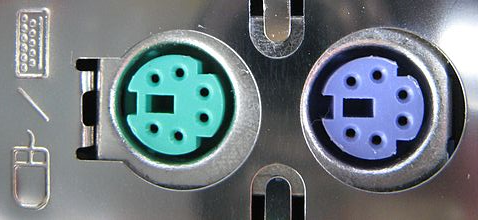Windows Didnt Install Wired External Keyboard Device the First Try How Do I Get It to Try Again
Keyboard Non Working In Windows Setup Or After The First Reboot
If your keyboard works normally in BIOS/UEFI setup, only does not work during Windows installation or stops working later on first reboot into Windows, and then near probable reason is missing USB 3.0 drivers.
While you can resolve this trouble by reverting to PS/2 keyboard or by toggling various options in BIOS/UEFI setup, much better approach is to integrate USB 3.0 drivers into Windows installation media.
Why I tin't just plug keyboard and mouse to USB 2.0 port?
You can't simply plug keyboard and mouse to USB 2.0 (black) port instead of USB three.0 (blue) port, because on modern estimator platforms (Intel Skylake, Intel Kaby Lake, Intel Cannon Lake and AMD Ryzen) all USB ports, including USB 2.0 ports, look like USB 3.0 ports from software point of view, so they all require USB three.0 drivers.
Method #1: Temporarily reverting to keyboard and mouse with PS/2 interface
PS/two port looks like this:


If your computer still has such port, and you notwithstanding accept a PS/ii keyboard and PS/2 mouse lying effectually, simplest way to solve this problem is reverting to human inteface devices with PS/2 interface for the time of Windows installation.
After Windows installation is finished, y'all may download USB three.0 drivers from website of your motherboard vendor, install these drivers, and then finally plug your modernistic USB keyboard and USB mouse.
Method #2: Enabling BIOS/UEFI setup pick to emulate PS/2 interface for USB HID
Usually at that place'due south an pick in BIOS/UEFI setup to emulate PS/two software interface for USB human interface devices (such every bit mice, keyboards and touchpads). Please note that on modern notebooks builtin keyboard and touchpad are often connected via internal USB interface, and then they fall into this category.
PS/2 emulation means that keyboard and mouse are notwithstanding continued to USB port, just from software signal of view (including drivers) they look like continued to PS/2 port.
After Windows installation is finished, you may download USB 3.0 drivers from website of your motherboard vendor, install these drivers, and and then finally disable PS/2 emulation for USB HID.
Delight notation: on some motherboards and notebooks PS/2 emulation for USB HID is automatically enabled when booting from removable media (such equally USB thumbdrive or CD/DVD disc), but PS/2 emulation for USB HID is disabled when booting from fixed media (such equally internal HDD or SSD). That's why you can observe your USB keyboard and mouse working usually during Windows installation, simply they suddenly stop working subsequently first reboot into installed Windows Bone.
Method #iii: Enabling BIOS/UEFI setup option to put USB 3.0 controller into USB ii.0 compatibility way
Some motherboards and laptops have BIOS/UEFI option to put USB 3.0 host controller into USB 2.0 compatibility fashion. Thought is the same as for PS/2 emulation: USB 3.0 controller looks like USB 2.0 controller from software point of view and so doesn't require any special drivers (albeit works slower).
Please note that this pick is relatively rare. Sometimes in BIOS/UEFI setup USB 2.0 is called EHCI (Enhanced Host Controller Interface) and USB 3.0 is called XHCI (eXtensible Host Controller Interface). UHCI is USB 1.0/i.1. Also this option may be hidden nether a very obscure name similar "Windows Bone version": "Windows seven" or "Windows 8+".
After Windows installation is finished, yous may download USB 3.0 drivers from website of your motherboard vendor, install these drivers, then finally put USB three.0 controller into fast fashion.
Too at that place's a thing called EHCI/XHCI hand-off: USB 3.0 controller is starting in the USB two.0 compatibility mode later beingness powered upward, just later it is switched to USB 3.0 mode, either by BIOS/UEFI firmware, or by Bone during kicking-up process (if USB 3.0 drivers are present in the OS). EHCI/XHCI manus-off sometimes leads to strange furnishings in dual-boot configurations involving Windows 10/11 and Windows seven: if Windows 7 is loaded after rebooting from Windows 10/11 (without full system ability-downwards), and then Windows 7 tin can't talk to USB hardware. This is because EHCI/XHCI hand-off persists across system reset (i.e. requires total power-downward to clear). Like effect is observed when installing Windows 7 via boot.wim borrowed from Windows 10/11 setup.
Method #4: Slipstreaming USB 3.0 drivers into Windows installation media
Aren't you tired of this rigmarole withal? We certainly are, that's why we take developed an fantabulous tool to slipstream USB three.0 and other drivers into Windows seven installation media: FlashBoot Pro.
Using FlashBoot, yous tin can install Windows vii to new PC or new laptop without any problems. Modern USB keyboard and mouse will work equally expected. Touchpad on laptops will work also. FlashBoot will prepare Windows installation USB thumbdrive with slipstreamed USB 3.0 and other drivers, and so yous tin can quickly and easily install Windows 7 to any new computer, regardless of BIOS/UEFI setup options, EHCI/XHCI hand-off and all other stuff.
FlashBoot Pro includes drivers for all known USB 3.0 controllers (Intel, AMD, ASMedia, Renesas and VIA), and then Windows 7 setup will work everywhere and will be peachy again!
Source: https://www.prime-expert.com/articles/b33/keyboard-not-working-in-windows-setup-or-after-the-first-reboot/
Belum ada Komentar untuk "Windows Didnt Install Wired External Keyboard Device the First Try How Do I Get It to Try Again"
Posting Komentar